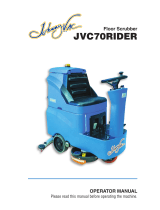
TABLE OF CONTENTS
SABER (SC) 86038350 01/29/07
Machine Data Log/Overview.........................2
Table of Contents..........................................3
HOW TO USE THIS MANUAL
How to use this Manual.................................1-1
SAFETY
Important Safety Instructions........................2-1
Hazard Intensity Level. .................................2-2
Safety Label Location. ..................................2-3
OPERATIONS
Technical Specifications. ..............................3-1
How the Machine Works...............................3-3
Components..................................................3-4
Controls.........................................................3-5
Machine Operation......................................3-10
Pre-Run Machine Inspection....................3-10
Starting Machine......................................3-10
Emergency Stop Procedures...................3-10
Filling the Solution Tank...........................3-10
Scrubbing.................................................3-10
Emptying & Cleaning Tanks.....................3-12
MAINTENANCE
Batteries........................................................4-1
Battery Maintenance..................................4-1
Checking Battery Specific Gravity..............4-2
Charging the Batteries...............................4-2
Changing Batteries. ...................................4-3
Battery Connections...................................4-3
Scrub Brushes. .............................................4-4
Types.........................................................4-4
Replacing or Installing Scrub Brushes.......4-4
Squeegee Blades..........................................4-6
Replace Squeegee Blade..........................4-6
Remove Squeegee Assembly....................4-6
Adjusting Deluxe Squeegee.......................4-6
Adjusting Squeegee Deflection..................4-7
Replacing Squeegee Blades......................4-7
Greasing Axles...........................................4-7
Service Schedule..........................................4-8
Machine Troubleshooting..............................4-9
GROUP PARTS LIST
Control Handle Group – Non-Traction..........5-1
Control Tower Group - Traction....................5-3
Decal Group..................................................5-5
Electrical Panel Group – Non-Traction.........5-7
Electrical Panel Group – Traction…………...5-9
Hour Meter……………………………………5-11
Recovery Tank Group................................. 5-13
Scrub Brush/Pad Driver Group .................. 5-15
Scrub Head Group – Non-Traction…………5-17
Scrub Head Group - Traction...................... 5-19
Scrub Head Lift Group – Non-Traction....... 5-21
Scrub Head Lift Group - Traction................ 5-23
Solution Tank Group – Non-Traction.......... 5-25
Solution Tank Group – Traction.................. 5-27
Squeegee Group ........................................ 5-29
Squeegee Lift Group................................... 5-31
Deluxe Squeegee Group............................ 5-33
Deluxe Squeegee Lift Group. ..................... 5-37
Vacuum Group............................................ 5-39
Wheels and Frame Group – Non-Traction.. 5-41
Wheels and Frame Group - Traction.......... 5-43
Onboard Charger........................................ 5-45
Wiring Group – Battery Cables................... 5-47
Wiring Group–Control Panel-Non-Traction 5-49
Wiring Group-Control Panel-Non-Traction
With Battery Charger.......................... 5-51
Wiring Group – Schematic – Non-Traction. 5-53
Wiring Group – Schematic – Non-Traction
Onboard Charging.............................. 5-55
Wiring Group – Schematic - Traction.......... 5-57
Wiring Group –Schematic – Traction and
Onboard Charging.............................. 5-59
Wiring Group – Control Panel - Traction..... 5-61
Wiring Group – Main Harness - Traction.... 5-63
Emergency Stop Option.............................. 5-65
Accessory Pump Option............................. 5-67
Suggested Spare Parts............................... 5-69
EC Declaration of Conformity..................... 5-70
Warranty..................................................... 5-71




















